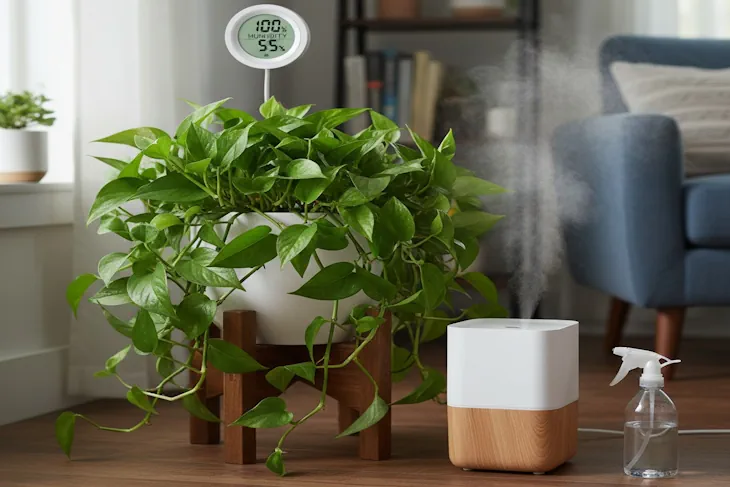Pothos (Epipremnum aureum) is known as one of the easiest houseplants to grow. But if you’ve ever wondered whether humidity plays a role in keeping it healthy, the answer is yes — pothos love moderate to high humidity. While they are tolerant of average indoor air, they grow best when the air isn’t too dry.
In this guide, we’ll explain the ideal humidity levels for pothos, how humidity affects their growth, and simple ways to give your plant the moisture it needs.
Do Pothos Like Humidity?
Yes, pothos prefer humidity levels between 50% and 70%. These plants come from tropical regions where the air is naturally warm and moist. In low humidity, pothos can still survive, but the leaves may grow smaller, develop brown edges, or look less vibrant.
The good news is: pothos are adaptable. Even if your indoor humidity is around 30%–40%, your plant will likely keep growing, but with a little extra humidity, it will look healthier and fuller.
Signs Your Pothos Needs More Humidity
Watch out for these symptoms:
-
Brown or crispy leaf tips and edges
-
Leaves curling inward
-
Slower growth compared to warmer months
-
Drooping or weak vines even after proper watering
If you notice these issues, your pothos may be struggling in dry air.
Best Humidity Level for Pothos
-
Ideal Range: 50%–70%
-
Minimum Tolerance: As low as 30% (typical in heated homes during winter)
-
High Humidity (>70%): Generally safe if air circulation is good. Prevents brown tips but can encourage fungal problems if stagnant.
How to Increase Humidity for Pothos Indoors
Here are simple methods to keep your pothos comfortable:
1. Use a Humidifier
The most effective way to maintain steady humidity. Place it near your pothos, especially in winter.
2. Group Plants Together
Plants naturally release moisture through transpiration. Keeping them close together creates a mini-humid environment.
3. Pebble Tray Method
Fill a shallow tray with pebbles and water. Place your pothos pot on top (not directly in the water). As the water evaporates, it adds moisture around the plant.
4. Mist Occasionally (With Care)
Light misting can temporarily boost humidity, but don’t overdo it. Wet leaves sitting in low airflow may attract pests or fungus.
5. Relocate to Naturally Humid Rooms
Bathrooms or kitchens often have higher humidity. If the lighting is good, pothos can thrive there.
Does Too Much Humidity Harm Pothos?
Yes, excessive humidity without airflow can cause issues like:
-
Yellowing leaves from fungal diseases
-
Mold or mildew on the soil surface
-
Higher risk of pests like fungus gnats
Balance is key — pair moderate humidity with good air circulation.
Seasonal Humidity Care
-
Spring & Summer: Natural humidity is usually enough. Regular watering and bright, indirect light will keep plants thriving.
-
Fall & Winter: Indoor heating can drop humidity below 30%. This is the time to use a humidifier, pebble trays, or plant grouping.
FAQs About Pothos and Humidity
Q: Do pothos need misting?
A: Not required, but light misting can help if your air is very dry. Just avoid leaving leaves wet for long.
Q: Can pothos grow in dry rooms?
A: Yes, they tolerate dry air, but leaves may get crispy tips. Adding some humidity will improve growth.
Q: What’s the best room for pothos?
A: Bathrooms and kitchens are great if they have good light — they naturally provide higher humidity.
Final Takeaway
Pothos don’t just tolerate humidity — they thrive in it. While they can survive in average home conditions, giving them 50%–70% humidity will keep leaves greener, prevent crispy tips, and encourage fuller growth.
With simple tricks like a humidifier, pebble tray, or grouping, you can create the perfect indoor environment for your pothos to shine.
